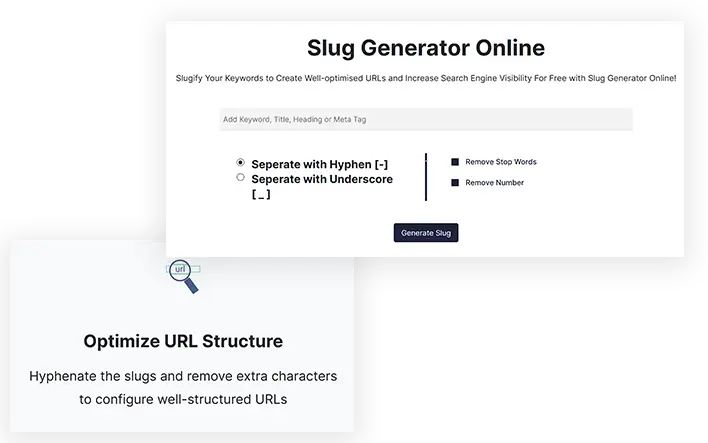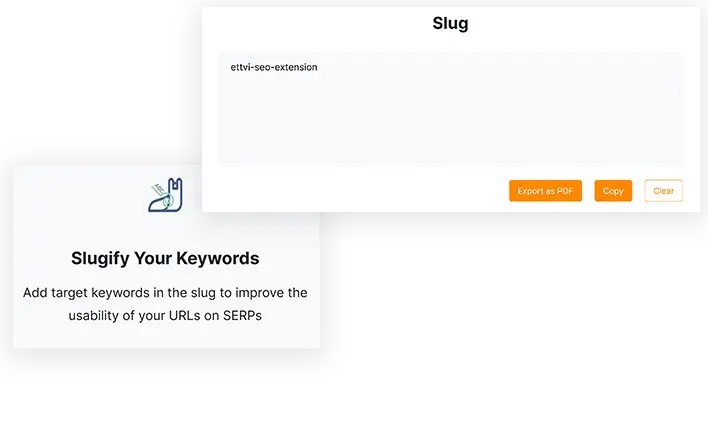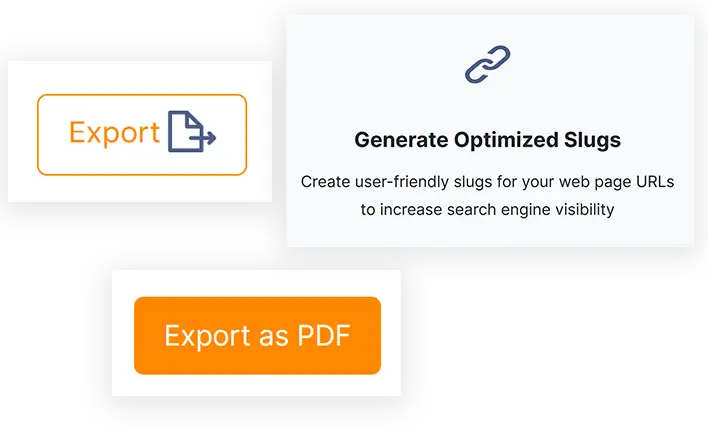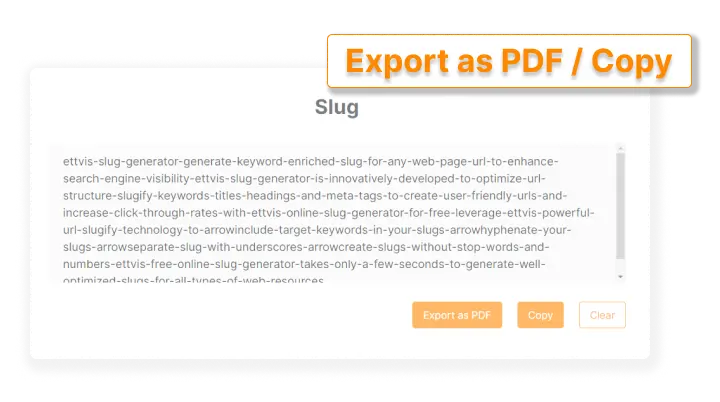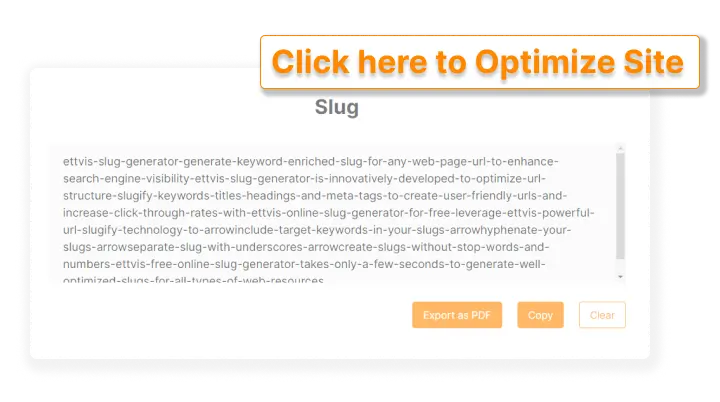A Comprehensive Guide to URL Slug SEO
ETTVI always tends to cater to the needs of its users. Therefore, we are here to tell you how you can create and optimize URL Slugs to drive organic traffic.
What is Slug in SEO?
Well-optimized URL slugs improves on-page SEO
The part of the URL that comes after the slash is what we call slug. It is generated to help both the user and search engines to particularly identify a web page or post.
For example, the URL of this web page is https://ettvi.com/slug-generator/. As you know that the https://ettvi.com/ is the main URL of this website, the part in the URL after the slash "on-page/slug-generator" is the slug of this webpage
You can have direct access to a web page or post by using the URL containing the slug of the respective web page or post.
Therefore, your URL slug must be well-structured and easy-to-remember.
Tip: Never forget to create slug for your web page URL because it contributes a lot to deliver a good user experience.
Now, let us help you to understand how the URL structure influences your website SEO. Keep reading to know all about URL Slugs in detail.
What is the URL?
URL stands for Uniform Resource Locator. As the name says, it is used to locate a resource on the internet. In simple words, a URL is a web address which refers to a particular website or web page.
Every website, web page, and post has its own unique address - both the users and search engines locate and open a web resource through its URL.
What is URL Structure?
A URL may consists of protocol, subdomain, domain, top-level domain, subdirectory, Parameters, port, HTML anchors, path, and most importantly the slug.
If we anatomize the URL https://ettvi.com/slug-generator/ then we find out that it has:
 Protocol - https
Protocol - https
 Subdomain - pro
Subdomain - pro
 Domain - ettvi
Domain - ettvi
 Top-level Domain - .com
Top-level Domain - .com
 Slug - slug-generator
Slug - slug-generator
The most important element in this URL is the part that comes after the top-level-domain which we call the slug.
The slug part of https://ettvi.com/slug-generator/ enables both the users and search engines to understand that this web page contains a slug generator tool.
For instance, if it was written as “https://ettvi.com/2021/08/tools/slug-generator.html” then would you have understood it at first glance? No.
For a well-structured URL, you must:
 Keep it to-the-point & short
Keep it to-the-point & short
 Include the focus keyword in slug
Include the focus keyword in slug
 Leverage the “https” security protocol
Leverage the “https” security protocol
 Avoid using parameters
Avoid using parameters
 Use the subdirectories appropriately
Use the subdirectories appropriately
How to Optimize a URL?
URLs have a direct impact on user experience because the users click through only those links which are well-structured.
You know what - SEOs believe that users don’t open the URLs with complex and lengthy structure. Simply, the users always opt for the URLs which are easy-to-read and highlight the content intent.
Now, comes the question: how to make your URLs optimized enough to highlight the content intent in an easy way?
Let us tell you a secret - the best way to optimize a URL is to add a short, simple, and keyword-enriched slug in it.
How Optimize URL Slug?
Slug is an important part of a web page URL. The slug in URL indicates the subject matter of the content of a web page and helps the users to identify what the respective web page is about before opening it. Ultimately, the URL slug stimulates the users to click through a link.
If you don’t know how to configure well-optimized URLs then get a hold of these useful tips.
Guidelines For Slug SEO: Add the target keyword
Add the target keyword
 Keep it short & simple
Keep it short & simple
 Make it easy-to-read
Make it easy-to-read
 Highlight the content intent
Highlight the content intent
 Exclude stop words and numbers
Exclude stop words and numbers
 Use hyphens to separate words
Use hyphens to separate words
How to Generate Optimized URL Slugs?
Thanks to AI technology, we can automatically generate well-optimized slugs for URLs.
Using the best slugify online tool such as the “Slug Generator”, the SEOs can easily generate URL slugs just as the search engine requires.
The advanced permalinks creators just ask the users to enter the focus keyword, 1st heading, title or any meta tag of the content for the automatic generation of well-optimized URL slugs.
You must know that the majority of the SEOs opt for WordPress because such a CMS makes it easy to create, optimize, and publish content on the web. However, those who don't rely on a CMS can still generate a slug like WordPress.
All you need is an advanced SEO slug generator for the automatic generation of optimized slugs and make a permanent room in the good books of search engines.
Why is URL Slug Important For SEO?
In the fewest possible words - URL slug is vital to SEO because it is important for users. The URLs with well-optimized slugs may not influence the web page ranking but definitely triggers the users to open and visit the respective web content.
When you keep your URL slug short, easy-to-read and keyword-enriched then it becomes easier for the users to understand the intent of your web content which in turn, makes them click on the URL and visit your website.
Always remember - whenever the users look for something on the search engine, they tend to open the web pages with well-optimized URL, title, and description.
You can use ETTVI’s advanced SEO Slug Generator to get well-optimized URL slugs for free of cost.
Is URL Slug and URL Path Same?
People think that the URL slug and URL path are the same. However, that’s not the case.
The URL path refers to a page’s exact location on a website. Whereas the URL slug indicates what a web page is about.
Well, URL slug can be a part of URL path.
Let’s consider an example.
URL: https://ettvi.com/tools/slug-generator/
URL Path: /tools/slug-generator/
URL Path: /tools/slug-generator/
URL Slug: /slug-generator/
What are the Best SEO Practices For URL Slugs?
The well-optimized URL Slugs are always Readable, Keyword-enriched, Lower-cased, and Hyphenated.
Let’s get a hold of the details of these SEO practices.
Prioritize ReadabilityReadable URL slugs are those which are easy-to-understand. It's the basic part of URL optimization - use simple words to create a short slug.
In a nutshell, the slug of a URL must consist of easy wording which highlights the content intent in a precise way.
Add Focus KeywordWhen we say “a URL highlights the content intent” then we mean that it includes the focus keyword which helps the users to understand the subject matter of the respective web content.
Inclusion of the focus keyword is considered a major part of Slug SEO. You should add only one main keyword in the URL slug of your web page or post.
Use Lowercase LettersYou must use lowercases when creating the Slug because the rest of the URL is always in small letters as well.
Leverage HyphensSEOs tend to use both the hyphens and underscores to create URL slugs as follows:
Hyphenated Slug: slug-generator
Underscored Slug: slug_generator
However, SEOs should prefer hyphens to separate words in slugs.
What is the Difference Between Permalink and Slug?
The permalink can be defined as the address of a web page whereas the slug is a part of the address. In simple words, the permalink is the entire URL and slug is the part of the URL which comes after the top-level domain.
We can say that the slugs indicate the name and subject (focus keyword) of the web pages or posts in a user-friendly manner.
What is the Best Permalink Structure?
The best permalink structure is the one which consists of the post name and highlights the content intent.
Well, there are some other permalink structure tags available using which we can change the URL slugs. We can use year, month, day, hour, minute, second, post id, post name, category or author name tags to customize the URL slugs as required.
How Long Should a URL Slug Be?
The slug of your URL must be short and simple - SEOs recommend that the ideal URL slug length is at least 4-word long.
So, you should use three to five words to create a well-structured URL slug.
How to Slugify Your Keywords?
The best way to generate a URL slug is to slugify the focus keyword. You can use your focus keyword to create the slug of your web page’s URL. Keep in mind that the keyword in slug makes it easier for the visitors to apprehend the content intent.



